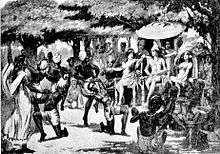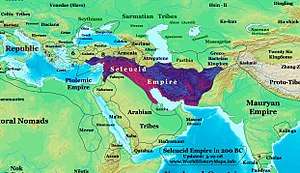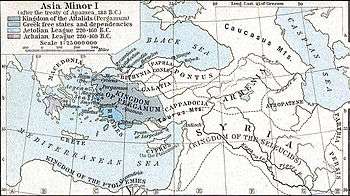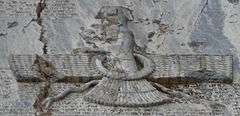Seleucid Empire
The Seleucid Empire (/sɪˈljuːsɪd/;[8] Ancient Greek: Βασιλεία τῶν Σελευκιδῶν, Basileía tōn Seleukidōn) was a Hellenistic state ruled by the Seleucid dynasty which existed from 312 BC to 63 BC; Seleucus I Nicator founded it following the division of the Macedonian Empire vastly expanded by Alexander the Great.[9][10][11][12] Seleucus received Babylonia (321 BC) and from there expanded his dominions to include much of Alexander's near-eastern territories. At the height of its power, the Empire included central Anatolia, Persia, the Levant, Mesopotamia, and what is now Kuwait, Afghanistan, and parts of Pakistan and Turkmenistan.
Seleucid Empire Βασιλεία τῶν Σελευκιδῶν Basileía tōn Seleukidōn | |||||||||||||||||||
|---|---|---|---|---|---|---|---|---|---|---|---|---|---|---|---|---|---|---|---|
| 312 BC–63 BC | |||||||||||||||||||
 Tetradrachm of Seleucus I – the horned horse, the elephant and the anchor all served as symbols of the Seleucid monarchy.[3][4]
| |||||||||||||||||||
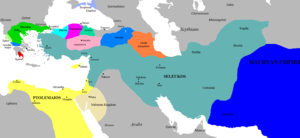 The Seleucid Empire in 281 BC on the eve of the murder of Seleucus I Nicator | |||||||||||||||||||
| Capital | |||||||||||||||||||
| Common languages | |||||||||||||||||||
| Religion | |||||||||||||||||||
| Government | Monarchy | ||||||||||||||||||
| Basileus | |||||||||||||||||||
• 305–281 BC | Seleucus I (first) | ||||||||||||||||||
• 65–63 BC | Philip II (last) | ||||||||||||||||||
| Historical era | Hellenistic period | ||||||||||||||||||
| 312 BC | |||||||||||||||||||
| 301 BC | |||||||||||||||||||
| 192–188 BC | |||||||||||||||||||
| 188 BC | |||||||||||||||||||
| 167–160 BC | |||||||||||||||||||
| 141 BC | |||||||||||||||||||
| 129 BC | |||||||||||||||||||
| 63 BC | |||||||||||||||||||
| Area | |||||||||||||||||||
| 303 BC[7] | 3,000,000 km2 (1,200,000 sq mi) | ||||||||||||||||||
| 301 BC[7] | 3,900,000 km2 (1,500,000 sq mi) | ||||||||||||||||||
| 240 BC[7] | 2,600,000 km2 (1,000,000 sq mi) | ||||||||||||||||||
| 175 BC[7] | 800,000 km2 (310,000 sq mi) | ||||||||||||||||||
| 100 BC[7] | 100,000 km2 (39,000 sq mi) | ||||||||||||||||||
| |||||||||||||||||||
The Seleucid Empire became a major center of Hellenistic culture – it maintained the preeminence of Greek customs where a Greek political elite dominated, mostly in the urban areas.[12][13][14][15] The Greek population of the cities who formed the dominant elite were reinforced by immigration from Greece.[12][13] Seleucid attempts to defeat their old enemy Ptolemaic Egypt were frustrated by Roman demands. Having come into conflict in the east (305 BC) with the Maurya Empire, Seleucus I entered into an agreement with its ruler, Chandragupta, whereby he ceded vast territory west of the Indus, including the Hindu Kush, modern-day Afghanistan, and the Balochistan province of Pakistan and offered his daughter in marriage to the Maurya Emperor to formalize the alliance.
Antiochus III the Great attempted to project Seleucid power and authority into Hellenistic Greece, but his attempts were thwarted by the Roman Republic and by Greek allies such as the Kingdom of Pergamon, culminating in a Seleucid defeat at the 190 BC Battle of Magnesia. In the subsequent Treaty of Apamea in 188 BC, the Seleucids were compelled to pay costly war reparations and relinquished claims to territories west of the Taurus Mountains.
The Parthians under Mithridates I of Parthia conquered much of the remaining eastern part of the Seleucid Empire in the mid-2nd century BC, while the independent Greco-Bactrian Kingdom continued to flourish in the northeast. However, the Seleucid kings continued to rule a rump state from Syria until the invasion by Armenian king Tigranes the Great in 83 BC and their ultimate overthrow by the Roman general Pompey in 63 BC.
Name
Contemporary sources, such as a loyalist decree honoring Antiochus I from Ilium, in Greek language define the Seleucid state both as an empire (arche) and as a kingdom (basileia). Similarly, Seleucid rulers were described as kings in Babylonia.[16]
Starting from the 2nd century BC, ancient writers referred to the Seleucid ruler as the King of Syria, Lord of Asia, and other designations;[17] the evidence for the Seleucid rulers representing themselves as kings of Syria is provided by the inscription of Antigonus son of Menophilus, who described himself as the "admiral of Alexander, king of Syria". He refers to either Alexander Balas or Alexander II Zabinas as a ruler.[18]
History
Partition of Alexander's empire
Alexander, who quickly conquered the Persian Empire under its last Achaemenid dynast, Darius III, died young in 323 BC, leaving an expansive empire of partly Hellenised culture without an adult heir. The empire was put under the authority of a regent in the person of Perdiccas, and the territories were divided among Alexander's generals, who thereby became satraps, at the Partition of Babylon, all in that same year.
Rise of Seleucus
Alexander's generals (the Diadochi) jostled for supremacy over parts of his empire. Ptolemy, a former general and the satrap of Egypt, was the first to challenge the new system; this led to the demise of Perdiccas. Ptolemy's revolt led to a new subdivision of the empire with the Partition of Triparadisus in 320 BC. Seleucus, who had been "Commander-in-Chief of the Companion cavalry" (hetairoi) and appointed first or court chiliarch (which made him the senior officer in the Royal Army after the regent and commander-in-chief Perdiccas since 323 BC, though he helped to assassinate him later) received Babylonia and, from that point, continued to expand his dominions ruthlessly. Seleucus established himself in Babylon in 312 BC, the year used as the foundation date of the Seleucid Empire.
Babylonian War (311–309 BC)
The rise of Seleucus in Babylon threatened the eastern extent of Antigonus I territory in Asia. Antigonus, along with his son Demetrius I of Macedon, unsuccessfully led a campaign to annex Babylon. The victory of Seleucus ensured his claim of Babylon and legitimacy. He ruled not only Babylonia, but the entire enormous eastern part of Alexander's empire, as described by Appian:
Always lying in wait for the neighboring nations, strong in arms and persuasive in council, he [Seleucus] acquired Mesopotamia, Armenia, 'Seleucid' Cappadocia, Persis, Parthia, Bactria, Arabia, Tapouria, Sogdia, Arachosia, Hyrcania, and other adjacent peoples that had been subdued by Alexander, as far as the river Indus, so that the boundaries of his empire were the most extensive in Asia after that of Alexander. The whole region from Phrygia to the Indus was subject to Seleucus.[19]
Seleucid–Mauryan War (305–303 BC)
In the region of Punjab, Chandragupta Maurya (Sandrokottos) founded the Maurya Empire in 321 BC. Chandragupta conquered the Nanda Empire in Magadha, and relocated to the capital of Pataliputra. Chandragupta then redirected his attention back to the Indus and by 317 BC he conquered the remaining Greek satraps left by Alexander. Expecting a confrontation, Seleucus gathered his army and marched to the Indus. It is said that Chandragupta himself fielded an army of 600,000 men and 9,000 war elephants.[20]
Mainstream scholarship asserts that Chandragupta received, formalized through a treaty, vast territory west of the Indus, including the Hindu Kush, modern day Afghanistan, and the Balochistan province of Pakistan.[21][22] Archaeologically, concrete indications of Mauryan rule, such as the inscriptions of the Edicts of Ashoka, are known as far as Kandahar in southern Afghanistan. According to Appian:
He [Seleucus] crossed the Indus and waged war with Sandrocottus [Maurya], king of the Indians, who dwelt on the banks of that stream, until they came to an understanding with each other and contracted a marriage relationship.[19]
It is generally thought that Chandragupta married Seleucus's daughter, or a Macedonian princess, a gift from Seleucus to formalize an alliance. In a return gesture, Chandragupta sent 500 war elephants,[23][24][25][26][27] a military asset which would play a decisive role at the Battle of Ipsus in 301 BC. In addition to this treaty, Seleucus dispatched an ambassador, Megasthenes, to Chandragupta, and later Deimakos to his son Bindusara, at the Mauryan court at Pataliputra (modern Patna in Bihar state). Megasthenes wrote detailed descriptions of India and Chandragupta's reign, which have been partly preserved to us through Diodorus Siculus. Later Ptolemy II Philadelphus, the ruler of Ptolemaic Egypt and contemporary of Ashoka the Great, is also recorded by Pliny the Elder as having sent an ambassador named Dionysius to the Mauryan court.[28]
The Indians occupy [in part] some of the countries situated along the Indus, which formerly belonged to the Persians: Alexander deprived the Ariani of them, and established there settlements of his own. But Seleucus Nicator gave them to Sandrocottus (Chandragupta Maurya) in consequence of a marriage contract, and received in return five hundred elephants.[29]
Other territories ceded before Seleucus' death were Gedrosia in the south-east of the Iranian plateau, and, to the north of this, Arachosia on the west bank of the Indus River.
Westward expansion

Following his and Lysimachus' victory over Antigonus Monophthalmus at the decisive Battle of Ipsus in 301 BC, Seleucus took control over eastern Anatolia and northern Syria.
In the latter area, he founded a new capital at Antioch on the Orontes, a city he named after his father. An alternative capital was established at Seleucia on the Tigris, north of Babylon. Seleucus's empire reached its greatest extent following his defeat of his erstwhile ally, Lysimachus, at Corupedion in 281 BC, after which Seleucus expanded his control to encompass western Anatolia. He hoped further to take control of Lysimachus's lands in Europe – primarily Thrace and even Macedonia itself, but was assassinated by Ptolemy Ceraunus on landing in Europe.
His son and successor, Antiochus I Soter, was left with an enormous realm consisting of nearly all of the Asian portions of the Empire, but faced with Antigonus II Gonatas in Macedonia and Ptolemy II Philadelphus in Egypt, he proved unable to pick up where his father had left off in conquering the European portions of Alexander's empire.
Breakup of Central Asian territories
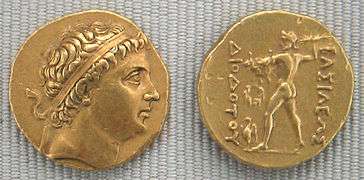

Antiochus I (reigned 281–261 BC) and his son and successor Antiochus II Theos (reigned 261–246 BC) were faced with challenges in the west, including repeated wars with Ptolemy II and a Celtic invasion of Asia Minor—distracting attention from holding the eastern portions of the Empire together. Towards the end of Antiochus II's reign, various provinces simultaneously asserted their independence, such as Bactria and Sogdiana under Diodotus, Cappadocia under Ariarathes III, and Parthia under Andragoras. A few years later, the latter was defeated and killed by the invading Parni of Arsaces – the region would then become the core of the Parthian Empire.
Diodotus, governor for the Bactrian territory, asserted independence in around 245 BC, although the exact date is far from certain, to form the Greco-Bactrian Kingdom. This kingdom was characterized by a rich Hellenistic culture and was to continue its domination of Bactria until around 125 BC when it was overrun by the invasion of northern nomads. One of the Greco-Bactrian kings, Demetrius I of Bactria, invaded India around 180 BC to form the Indo-Greek Kingdoms.
The rulers of Persis, called Fratarakas, also seem to have established some level of independence from the Seleucids during the 3rd century BC, especially from the time of Vahbarz. They would later overtly take the title of Kings of Persis, before becoming vassals to the newly formed Parthian Empire.[30][31]
The Seleucid satrap of Parthia, named Andragoras, first claimed independence, in a parallel to the secession of his Bactrian neighbour. Soon after, however, a Parthian tribal chief called Arsaces invaded the Parthian territory around 238 BC to form the Arsacid dynasty, from which the Parthian Empire originated.
Antiochus II's son Seleucus II Callinicus came to the throne around 246 BC. Seleucus II was soon dramatically defeated in the Third Syrian War against Ptolemy III of Egypt and then had to fight a civil war against his own brother Antiochus Hierax. Taking advantage of this distraction, Bactria and Parthia seceded from the empire. In Asia Minor too, the Seleucid dynasty seemed to be losing control: the Gauls had fully established themselves in Galatia, semi-independent semi-Hellenized kingdoms had sprung up in Bithynia, Pontus, and Cappadocia, and the city of Pergamum in the west was asserting its independence under the Attalid Dynasty. The Seleucid economy started to show the first signs of weakness, as Galatians gained independence and Pergamum took control of coastal cities in Anatolia. Consequently, they managed to partially block contact with the West.[33]
Revival (223–191 BC)
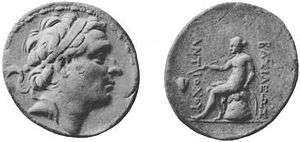
A revival would begin when Seleucus II's younger son, Antiochus III the Great, took the throne in 223 BC. Although initially unsuccessful in the Fourth Syrian War against Egypt, which led to a defeat at the Battle of Raphia (217 BC), Antiochus would prove himself to be the greatest of the Seleucid rulers after Seleucus I himself. He spent the next ten years on his anabasis (journey) through the eastern parts of his domain and restoring rebellious vassals like Parthia and Greco-Bactria to at least nominal obedience. He won the Battle of the Arius and besieged the Bactrian capital, and even emulated Alexander with an expedition into India where he met with king Sophagasenus (Sanskrit: Subhagasena) receiving war elephants.
Actual translation of Polybius 11.34 (No other source except Polybius makes any reference to Sophagasenus):
He [Antiochus] crossed the Caucasus Indicus (Paropamisus) (Hindu Kush) and descended into India; renewed his friendship with Sophagasenus the king of the Indians; received more elephants, until he had a hundred and fifty altogether; and having once more provisioned his troops, set out again personally with his army: leaving Androsthenes of Cyzicus the duty of taking home the treasure which this king had agreed to hand over to him.[34] Having traversed Arachosia and crossed the river Enymanthus, he came through Drangene to Carmania; and as it was now winter, he put his men into winter quarters there.[35]
When he returned to the west in 205 BC, Antiochus found that with the death of Ptolemy IV, the situation now looked propitious for another western campaign. Antiochus and Philip V of Macedon then made a pact to divide the Ptolemaic possessions outside of Egypt, and in the Fifth Syrian War, the Seleucids ousted Ptolemy V from control of Coele-Syria. The Battle of Panium (198 BC) definitively transferred these holdings from the Ptolemies to the Seleucids. Antiochus appeared, at the least, to have restored the Seleucid Kingdom to glory.
Expansion into Greece and war with Rome
Following the defeat of his erstwhile ally Philip by Rome in 197 BC, Antiochus saw the opportunity for expansion into Greece itself. Encouraged by the exiled Carthaginian general Hannibal, and making an alliance with the disgruntled Aetolian League, Antiochus launched an invasion across the Hellespont. With his huge army he aimed to establish the Seleucid empire as the foremost power in the Hellenic world, but these plans put the empire on a collision course with the new rising power of the Mediterranean, the Roman Republic. At the battles of Thermopylae (191 BC) and Magnesia (190 BC), Antiochus's forces suffered resounding defeats, and he was compelled to make peace and sign the Treaty of Apamea (188 BC), the main clause of which saw the Seleucids agree to pay a large indemnity, to retreat from Anatolia and to never again attempt to expand Seleucid territory west of the Taurus Mountains. The Kingdom of Pergamum and the Republic of Rhodes, Rome's allies in the war, gained the former Seleucid lands in Anatolia. Antiochus died in 187 BC on another expedition to the east, where he sought to extract money to pay the indemnity.
Roman power, Parthia and Judea
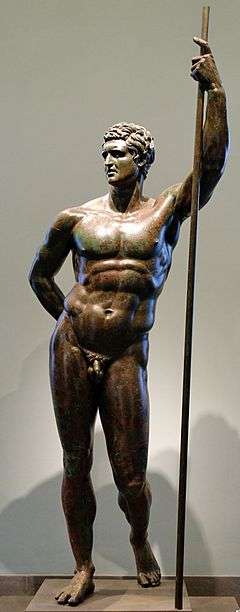
The reign of his son and successor Seleucus IV Philopator (187–175 BC) was largely spent in attempts to pay the large indemnity, and Seleucus was ultimately assassinated by his minister Heliodorus.
Seleucus' younger brother, Antiochus IV Epiphanes, now seized the throne. He attempted to restore Seleucid power and prestige with a successful war against the old enemy, Ptolemaic Egypt, which met with initial success as the Seleucids defeated and drove the Egyptian army back to Alexandria itself. As the king planned on how to conclude the war, he was informed that Roman commissioners, led by the Proconsul Gaius Popillius Laenas, were near and requesting a meeting with the Seleucid king. Antiochus agreed, but when they met and Antiochus held out his hand in friendship, Popilius placed in his hand the tablets on which was written the decree of the senate and told him to read it. When the king said that he would call his friends into council and consider what he ought to do, Popilius drew a circle in the sand around the king's feet with the stick he was carrying and said, "Before you step out of that circle give me a reply to lay before the senate." For a few moments he hesitated, astounded at such a peremptory order, and at last replied, "I will do what the senate thinks right." He then chose to withdraw rather than set the empire to war with Rome again.[36]
The latter part of his reign saw a further disintegration of the Empire despite his best efforts. Weakened economically, militarily and by loss of prestige, the Empire became vulnerable to rebels in the eastern areas of the empire, who began to further undermine the empire while the Parthians moved into the power vacuum to take over the old Persian lands. Antiochus' aggressive Hellenizing (or de-Judaizing) activities provoked a full scale armed rebellion in Judea—the Maccabean Revolt.[37] Efforts to deal with both the Parthians and the Jews as well as retain control of the provinces at the same time proved beyond the weakened empire's power. Antiochus died during a military expedition against the Parthians in 164 BC.
Civil war and further decay
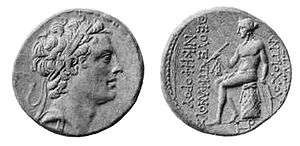
After the death of Antiochus IV Epiphanes, the Seleucid Empire became increasingly unstable. Frequent civil wars made central authority tenuous at best. Epiphanes' young son, Antiochus V Eupator, was first overthrown by Seleucus IV's son, Demetrius I Soter in 161 BC. Demetrius I attempted to restore Seleucid power in Judea particularly, but was overthrown in 150 BC by Alexander Balas – an impostor who (with Egyptian backing) claimed to be the son of Epiphanes. Alexander Balas reigned until 145 BC when he was overthrown by Demetrius I's son, Demetrius II Nicator. Demetrius II proved unable to control the whole of the kingdom, however. While he ruled Babylonia and eastern Syria from Damascus, the remnants of Balas' supporters – first supporting Balas' son Antiochus VI, then the usurping general Diodotus Tryphon – held out in Antioch.
Meanwhile, the decay of the Empire's territorial possessions continued apace. By 143 BC, the Jews in the form of the Maccabees had fully established their independence. Parthian expansion continued as well. In 139 BC, Demetrius II was defeated in battle by the Parthians and was captured. By this time, the entire Iranian Plateau had been lost to Parthian control.
Demetrius Nicator's brother, Antiochus VII Sidetes, took the throne after his brother's capture. He faced the enormous task of restoring a rapidly crumbling empire, one facing threats on multiple fronts. Hard-won control of Coele-Syria was threatened by the Jewish Maccabee rebels. Once-vassal dynasties in Armenia, Cappadocia, and Pontus were threatening Syria and northern Mesopotamia; the nomadic Parthians, brilliantly led by Mithridates I of Parthia, had overrun upland Media (home of the famed Nisean horse herd); and Roman intervention was an ever-present threat. Sidetes managed to bring the Maccabees to heel and frighten the Anatolian dynasts into a temporary submission; then, in 133, he turned east with the full might of the Royal Army (supported by a body of Jews under the Hasmonean prince, John Hyrcanus) to drive back the Parthians.
Sidetes' campaign initially met with spectacular success, recapturing Mesopotamia, Babylonia, and Media. In the winter of 130/129 BC, his army was scattered in winter quarters throughout Media and Persis when the Parthian king, Phraates II, counter-attacked. Moving to intercept the Parthians with only the troops at his immediate disposal, he was ambushed and killed at the Battle of Ecbatana in 129 BC. Antiochus Sidetes is sometimes called the last great Seleucid king.
After the death of Antiochus VII Sidetes, all of the recovered eastern territories were recaptured by the Parthians. The Maccabees again rebelled, civil war soon tore the empire to pieces, and the Armenians began to encroach on Syria from the north.
Collapse (100–63 BC)
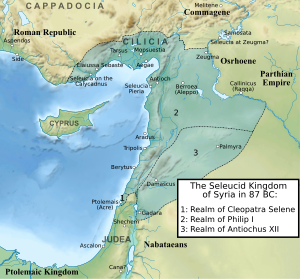
By 100 BC, the once formidable Seleucid Empire encompassed little more than Antioch and some Syrian cities. Despite the clear collapse of their power, and the decline of their kingdom around them, nobles continued to play kingmakers on a regular basis, with occasional intervention from Ptolemaic Egypt and other outside powers. The Seleucids existed solely because no other nation wished to absorb them – seeing as they constituted a useful buffer between their other neighbours. In the wars in Anatolia between Mithridates VI of Pontus and Sulla of Rome, the Seleucids were largely left alone by both major combatants.
Mithridates' ambitious son-in-law, Tigranes the Great, king of Armenia, however, saw opportunity for expansion in the constant civil strife to the south. In 83 BC, at the invitation of one of the factions in the interminable civil wars, he invaded Syria and soon established himself as ruler of Syria, putting the Seleucid Empire virtually at an end.
Seleucid rule was not entirely over, however. Following the Roman general Lucullus' defeat of both Mithridates and Tigranes in 69 BC, a rump Seleucid kingdom was restored under Antiochus XIII. Even so, civil wars could not be prevented, as another Seleucid, Philip II, contested rule with Antiochus. After the Roman conquest of Pontus, the Romans became increasingly alarmed at the constant source of instability in Syria under the Seleucids. Once Mithridates was defeated by Pompey in 63 BC, Pompey set about the task of remaking the Hellenistic East, by creating new client kingdoms and establishing provinces. While client nations like Armenia and Judea were allowed to continue with some degree of autonomy under local kings, Pompey saw the Seleucids as too troublesome to continue; doing away with both rival Seleucid princes, he made Syria into a Roman province.
Culture
.jpg)
The Seleucid empire's geographical span, from the Aegean Sea to what is now Afghanistan and Pakistan, created a melting pot of various peoples, such as Greeks, Armenians, Georgians, Persians, Medes, Assyrians and Jews. The immense size of the empire, followed by its encompassing nature, encouraged the Seleucid rulers to implement a policy of ethnic unity—a policy initiated by Alexander.
The Hellenization of the Seleucid empire was achieved by the establishment of Greek cities throughout the empire. Historically significant towns and cities, such as Antioch, were created or renamed with more appropriate Greek names. The creation of new Greek cities and towns was aided by the fact that the Greek mainland was overpopulated and therefore made the vast Seleucid empire ripe for colonization. Colonization was used to further Greek interest while facilitating the assimilation of many native groups. Socially, this led to the adoption of Greek practices and customs by the educated native classes in order to further themselves in public life, and at the same time the ruling Macedonian class gradually adopted some of the local traditions. By 313 BC, Hellenic ideas had begun their almost 250-year expansion into the Near East, Middle East, and Central Asian cultures. It was the empire's governmental framework to rule by establishing hundreds of cities for trade and occupational purposes. Many of the existing cities began—or were compelled by force—to adopt Hellenized philosophic thought, religious sentiments, and politics although the Seleucid rulers did incorporate Babylonian religious tenets to gain support.[39]
Synthesizing Hellenic and indigenous cultural, religious, and philosophical ideas met with varying degrees of success—resulting in times of simultaneous peace and rebellion in various parts of the empire. Such was the case with the Jewish population of the Seleucid empire; the Jews' refusal to willingly Hellenize their religious beliefs or customs posed a significant problem which eventually led to war. Contrary to the accepting nature of the Ptolemaic empire towards native religions and customs, the Seleucids gradually tried to force Hellenization upon the Jewish people in their territory by outlawing Judaism. This eventually led to the revolt of the Jews under Seleucid control, which would later lead to the Jews achieving independence from the Seleucid empire.
Family tree of Seleucids
| Seleucus | |||||||||||||||||||||||||||||||||||||||||||||||||||||||||||||||||||||
| Laodice of Macedonia | Antiochus from Orestia, Macedonia | Ptolemy somatophylax | |||||||||||||||||||||||||||||||||||||||||||||||||||||||||||||||||||
| 1.Apama daughter of Spitamenes satrap of Sogdiana | Seleucus I Nikator emperor of Seleucid Empire 305–281 BC | 2.Stratonice daughter of Demetrius I king of Macedonia | Didymeia | ||||||||||||||||||||||||||||||||||||||||||||||||||||||||||||||||||
| Stratonice of Syria daughter of Demetrius I king of Macedonia | (1) Antiochus I Soter emperor of Seleucid Empire 281–261 BC | (1) Achaeus the Elder landowner in Asia Minor | (2) Phila ∞ Antigonus II Gonatas king of Macedonia | ||||||||||||||||||||||||||||||||||||||||||||||||||||||||||||||||||
| Apama II ∞ Magas king of Cyrene | Stratonice ∞ Demetrius II king of Macedon | 2.Berenice daughter of Ptolemy II king of Egypt | Antiochus II Theos emperor of Seleucid Empire 261–246 BC | 1.Laodice I | Laodice II ∞ Seleucus II Callinicus | Alexander landowner in Asia Minor | Andromachus landowner in Asia Minor | Antiochis ∞ Attalus Attalid dynasty | |||||||||||||||||||||||||||||||||||||||||||||||||||||||||||||
| Laodice II daughter of Achaeus landowner in Asia Minor | (1) Seleucus II Callinicus emperor of Seleucid Empire 246–225 BC | (1) Antiochus Hierax ruler of Asia Minor | (1) Stratonice ∞ Ariarathes III of Cappadocia | (1) Laodice ∞ Mithridates II of Pontus | Achaeus commander of Asia Minor | Laodice daughter of Mithridates II of Pontus | |||||||||||||||||||||||||||||||||||||||||||||||||||||||||||||||
| Antiochis ∞ Xerxes king of Sophene & Commagene | Seleucus III Ceraunus emperor of Seleucid Empire 225–223 BC | Antiochus III the Great emperor of Seleucid Empire 222–187 BC | Laodice III daughter of Mithridates II of Pontus | ||||||||||||||||||||||||||||||||||||||||||||||||||||||||||||||||||
| Cleopatra I Syra ∞ Ptolemy V of Egypt | Antiochus co-emperor 210–193 BC | Laodice IV ∞ 3.Antiochus IV Epiphanes | Seleucus IV Philopator emperor of Seleucid Empire 187–175 BC | Antiochus IV Epiphanes emperor of Seleucid Empire 175–164 BC | Antiochis ∞ Ariarathes IV of Cappadocia | ||||||||||||||||||||||||||||||||||||||||||||||||||||||||||||||||
| Nyssa ∞ Pharnaces I of Pontus Mithridatic dynasty | Laodice V ∞ Perseus king of Macedonia | Demetrius I Soter emperor of Seleucid Empire 161–150 BC | Antiochus V Eupator emperor of Seleucid Empire 164–161 BC | Laodice VI ∞ Mithridates V of Pontus Mithridatic dynasty | Laodice ∞ Mithridates III of Pontus | Alexander Balas emperor of Seleucid Empire 150/152–146 BC | Cleopatra Thea daughter of Ptolemy VI of Egypt | ||||||||||||||||||||||||||||||||||||||||||||||||||||||||||||||
| 2.Rhodogune of Parthia daughter of Mithridates I of Parthia | Demetrius II Nicator emperor of Seleucid Empire 145–138 BC | 1.Cleopatra Thea daughter of Ptolemy VI of Egypt queen of Syria 126–121 BC | Antiochus VII Sidetes emperor of Seleucid Empire 138–129 BC | Antiochus VI Dionysus emperor of Seleucid Empire 144–142/1 BC | |||||||||||||||||||||||||||||||||||||||||||||||||||||||||||||||||
| (1) Seleucus V Philometor co-king of Syria 126–125 BC | 1.Tryphaena daughter of Ptolemy VIII of Egypt | (1) Antiochus VIII Grypus co-king of Syria 125–122 BC king of Syria 122–96 BC | 2.Cleopatra Selene daughter of Ptolemy VIII of Egypt | Antiochus IX Cyzicenus king of Syria 116–96 BC | Cleopatra IV of Egypt daughter of Ptolemy VIII of Egypt | Alexander II Zabinas king of Syria 128–123 BC | |||||||||||||||||||||||||||||||||||||||||||||||||||||||||||||||
| (1) Seleucus VI Epiphanes king of Syria 96–94 BC | (1) Antiochus XI Epiphanes king of Syria 94–93 BC | (1) Laodice VII Thea ∞ Mithridates I Callinicus king of Commagene | (1) Philip I Philadelphus king of Syria 94–83/75 BC | (1) Demetrius III Eucaerus king of Syria 96–87 BC | (1) Antiochus XII Dionysus king of Syria 87–82 BC | Antiochus X Eusebes king of Syria 95–92/88 BC | Cleopatra Selene daughter of Ptolemy VIII of Egypt | ||||||||||||||||||||||||||||||||||||||||||||||||||||||||||||||
| Philip II Philoromaeus king of Syria 65–64 BC | Antiochus XIII Asiaticus king of Syria 69–64 BC | Seleucus VII Philometor king of Syria 83–69 BC | Berenice IV daughter of Ptolemy XII of Egypt | ||||||||||||||||||||||||||||||||||||||||||||||||||||||||||||||||||
List of Seleucid rulers
See also
References
- Cohen, Getzel M; The Hellenistic Settlements in Syria, the Red Sea Basin, and North Africa, p. 13.
- Lynette G. Mitchell; Every Inch a King: Comparative Studies on Kings and Kingship in the Ancient and Medieval Worlds, p. 123.
- Cohen, Getzel M; The Hellenistic Settlements in Syria, the Red Sea Basin, and North Africa, p. 13.
- Lynette G. Mitchell; Every Inch a King: Comparative Studies on Kings and Kingship in the Ancient and Medieval Worlds, p. 123.
- Richard N. Frye, The History of Ancient Iran, (Ballantyne Ltd, 1984), 164.
- Julye Bidmead, The Akitu Festival: Religious Continuity and Royal Legitimation in Mesopotamia, (Gorgias Press, 2004), 143.
- Taagepera, Rein (1979). "Size and Duration of Empires: Growth-Decline Curves, 600 B.C. to 600 A.D.". Social Science History. 3 (3/4): 121. doi:10.2307/1170959. JSTOR 1170959.
- Oxford English Dictionary, 1st ed. "Seleucid, n. and adj." Oxford University Press (Oxford), 1911.
- Jones, Kenneth Raymond (2006). Provincial reactions to Roman imperialism: the aftermath of the Jewish revolt, A.D. 66-70, Parts 66-70. University of California, Berkeley. p. 174. ISBN 978-0-542-82473-9.
... and the Greeks, or at least the Greco-Macedonian Seleucid Empire, replace the Persians as the Easterners.
- Society for the Promotion of Hellenic Studies (London, England) (1993). The Journal of Hellenic studies, Volumes 113-114. Society for the Promotion of Hellenic Studies. p. 211.
The Seleucid kingdom has traditionally been regarded as basically a Greco-Macedonian state and its rulers thought of as successors to Alexander.
- Baskin, Judith R.; Seeskin, Kenneth (2010). The Cambridge Guide to Jewish History, Religion, and Culture. Cambridge University Press. p. 37. ISBN 978-0-521-68974-8.
The wars between the two most prominent Greek dynasties, the Ptolemies of Egypt and the Seleucids of Syria, unalterably change the history of the land of Israel…As a result the land of Israel became part of the empire of the Syrian Greek Seleucids.
- Glubb, John Bagot (1967). Syria, Lebanon, Jordan. Thames & Hudson. p. 34. OCLC 585939.
In addition to the court and the army, Syrian cities were full of Greek businessmen, many of them pure Greeks from Greece. The senior posts in the civil service were also held by Greeks. Although the Ptolemies and the Seleucids were perpetual rivals, both dynasties were Greek and ruled by means of Greek officials and Greek soldiers. Both governments made great efforts to attract immigrants from Greece, thereby adding yet another racial element to the population.
- Steven C. Hause; William S. Maltby (2004). Western civilization: a history of European society. Thomson Wadsworth. p. 76. ISBN 978-0-534-62164-3.
The Greco-Macedonian Elite. The Seleucids respected the cultural and religious sensibilities of their subjects but preferred to rely on Greek or Macedonian soldiers and administrators for the day-to-day business of governing. The Greek population of the cities, reinforced until the second century BC by immigration from Greece, formed a dominant, although not especially cohesive, elite.
- Victor, Royce M. (2010). Colonial education and class formation in early Judaism: a postcolonial reading. Continuum International Publishing Group. p. 55. ISBN 978-0-567-24719-3.
Like other Hellenistic kings, the Seleucids ruled with the help of their "friends" and a Greco-Macedonian elite class separate from the native populations whom they governed.
- Britannica, Seleucid kingdom, 2008, O.Ed.
- Susan M. Sherwin-White; Ama1/2lie Kuhrt (1993). From Samarkhand to Sardis: A New Approach to the Seleucid Empire. University of California Press. p. 40. ISBN 978-0-520-08183-3.
- Nigel Wilson (2013). Encyclopedia of Ancient Greece. p. 652. ISBN 9781136788000.
- Paul J. Kosmin (2014). The Land of the Elephant Kings. p. 112. ISBN 9780674728820.
- Appian, History of Rome, "The Syrian Wars" 55
- Pliny, Natural History VI, 22.4
- Vincent A. Smith (1972). Aśoka. Asian Educational Services. ISBN 81-206-1303-1.
- Clark, Walter Eugene (1919). "The Importance of Hellenism from the Point of View of Indic-Philology". Classical Philology. 14 (4): 297–313. doi:10.1086/360246.
- Vijay Katchroo. Ancient India, p. 196
- William Hunter. The Imperial Gazetteer of India. p. 167
- C. D. Darlington. The evolution of man and society. p. 223
- Tarn, W. W. (1940). "Two Notes on Seleucid History: 1. Seleucus' 500 Elephants, 2. Tarmita". Journal of Hellenic Studies. 60: 84–94. doi:10.2307/626263. JSTOR 626263.
- Partha Sarathi Bose (2003). Alexander the Great's Art of Strategy. Gotham Books. ISBN 1-59240-053-1.
- Pliny the Elder, "The Natural History", Chap. 21 Archived 2013-07-28 at the Wayback Machine
- Strabo 15.2.1(9)
- Engels, David (201). "Iranian Identity and Seleucid Allegiance: Vahbarz, the Frataraka and Early Arsacid Coinage". In K. Erickson (ed.). The Seleukid Empire, 281–222 BC: War within the Family. Swansea. pp. 173–196.
- Erickson, Kyle (2018). The Seleukid Empire 281–222 BC: War Within the Family. ISD LLC. p. 175. ISBN 9781910589953.
- Kosmin, Paul J. (2018). Time and Its Adversaries in the Seleucid Empire. Harvard University Press. p. 207. ISBN 9780674976931.
- Castrén, Paavo (2011). Uusi antiikin historia (in Finnish). Otava. p. 244. ISBN 978-951-1-21594-3.
- Kosmin 2014, pp. 35–36.
- Polybius, Histories, Book 11, 1889, p 78, trans. Friedrich Otto Hultsch, Evelyn Shirley Shuckburgh
- "Livy's History of Rome". mu.edu.
- Chanukah, Shabbat 21b, Babylonian Talmud
- "History of Iran: Seleucid Empire". iranchamber.com.
- Julye Bidmead, The Akitu Festival: Religious Continuity and Royal Legitimation in Mesopotamia, 143.
Further reading
- G. G. Aperghis, The Seleukid Royal Economy. The Finances and Financial Administration of the Seleukid Empire, Cambridge, 2004.
- Laurent Capdetrey, Le pouvoir séleucide. Territoire, administration, finances d'un royaume hellénistique (312-129 avant J.C.). (Collection "Histoire"). Rennes: Presses Universitaires de Rennes, 2007.
- D. Engels, Benefactors, Kings, Rulers. Studies on the Seleukid Empire between East and West, Leuven, 2017 (Studia Hellenistica 57).
- A. Houghton, C. Lorber, Seleucid Coins. A Comprehensive Catalogue, Part I, Seleucus I through Antiochus III, With Metrological Tables by B. Kritt, I-II, New York - Lancaster - London, 2002.
- Paul J. Kosmin, The Land of the Elephant Kings: Space, Territory, and Ideology in the Seleucid Empire (Cambridge, MA: Harvard University Press, 2014).
- R. Oetjen (ed.), New Perspectives in Seleucid History, Archaeology and Numismatics: Studies in Honor of Getzel M. Cohen, Berlin – Boston: De Gruyter, 2020.
- Michael J. Taylor, Antiochus the Great (Barnsley: Pen and Sword, 2013).
External links
| Library resources about Seleucid Empire |
- Livius, The Seleucid Empire by Jona Lendering
- Genealogy of the Seleucids
- Seleukid Bibliography maintained at the History Department of Utrecht University
- Seleucid Research Bibliography, compiled and maintained by the Seleucid Study Group
